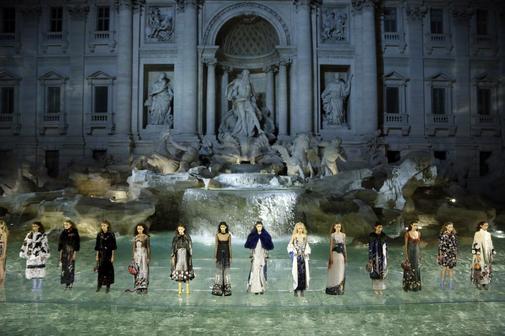According to the sociologist Gilles Lipovetsky, one of the keys to the success of luxury brands is to build a clear identity projected in time and space. Can there be, then, something more ambitious for a firm than merging with the Eternal City? This is the bet of Bulgari, Fendi or Tod's, luxury houses that in recent years have become the true patron of the most iconic monuments of Rome , taking advantage of the financial straits of the Italian Public Administration to take charge of the restoration of His architectural jewels.
In the case of Bulgari , for example, what unites the famous staircase and the jewelry boutique of the Via dei Condotti, the most exclusive street in Rome, are not just a few steps. The jewelery firm is responsible for the travertine marble of the stair steps looking brighter since 2016. It was in that year that, after 10 months of work, the monument was reopened to the public thanks to the donation of the brand: 1.5 million euros to clean, consolidate and protect one of the most emblematic places in the city.
But the connection between the two already existed, because Sotirio Bulgari, the talented Greek silversmith who founded the house that bears his name in 1884, lived in one of the streets that is located on the steps of that staircase , on the Sistina road, where also opened the first store of the firm. As a tribute to its origins, the brand took advantage of its 130th anniversary to carry out a triple project that included the restoration of the Piazza di Spagna, the polychrome mosaic of the Baths of Caracalla, which had been closed to the public for more than 40 years, and, as a brooch In the end, the improvement of the Largo Argentina area, a construction from the 3rd century BC, in which Emperor Julio César was stabbed, whose work will end in 2021.
Fendi's sources
If Bulgari is not understood without Rome, neither Fendi. Founded in the early twentieth century, the firm has also paid tribute to its hometown through the Fendi for Fountains initiative, aimed at restoring some of its most important sources. Among them, the Trevi Fountain, which needed more than all the coins it collects every day to recover its splendor. In the 17 months that the works lasted, initiated in 2014, Fendi donated about 2.4 million euros to ensure the good condition of this jewel of the Baroque, designed by Lorenzo Bernini.
Despite the philanthropic nature of the project, the firm could not avoid the juicy idea of taking advantage of the reopening of the monument to celebrate the 90th anniversary of the maison with one of the most spectacular fashion shows the world of fashion has seen . The recently deceased Karl Lagerfeld, director of the house, presented to his mannequins which modern fairies parading over the waters of the fountain, in which a gigantic glass walkway was installed.
Saving the suspicions that could be generated by the Fendi parade, the truth is that these brands have avoided marketing their patronage, although their image has not ceased to benefit. As Silvia Ortega, professor of the ISEM and author of The new luxury experiences, keys and protagonists explains, these are great communication actions for luxury brands: «The link with art raises its position as guardians of heritage, culturally legitimizes them and they have a commercial nature , ”he says.
But so far, no project was as colossal and generous as Tod's. The firm specializing in the manufacture of footwear and accessories invested 25 million euros to repair another of the great symbols of Rome: for the first time in its history, the Colosseum dressed in scaffolding during the five years that the works lasted.
In 2016, during the inauguration of the first phase, the then President of the Council of Ministers, Matteo Renzi, thanked the businessman Diego Della Valle, owner of the group, for his donation and launched a new policy of tax incentives that benefited all those companies that help recover historical heritage . "This is not just a great restoration operation, but the example of what Italy wants to offer Europe: the recovery of our cultural identity," he said then.
The fashion house was also the first to launch such initiatives in Italy, encouraging other entrepreneurs to promote public-private collaboration. A formula that also generated critical voices that cast doubt on the altruistic nature of Tod's project. Della Valle replied that his purpose was "to be custodians and not owners" of the estate.
Silvia Ortega highlights that the place where a project is conceived is one of the most attractive differential attributes that a brand has. And who doesn't want to merge with Eternal City?
According to the criteria of The Trust Project
Know more- Fendi
- Italy
- Luxury houses
- Luxury
- culture
- fashion
Lifestyle Jonathan Anderson, the genius who has reinvented Loewe: "Luxury has become a dirty word"
ALICANTE STREET STYLE Laguna garden
Fashion Katy Perry ends one of the myths of fashion with her latest look

